

Jigsaw. Best practices for whiteboarding in the physics classroom. Whiteboards are an indispensable tool that physicists use to work out ideas individually and collaboratively, and to present those ideas, both for public discussion and critique of tentative ideas and for communication of more fully formed ideas.
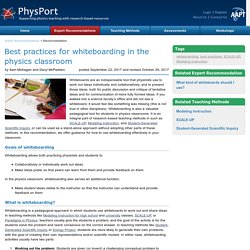
If you walked into a science faculty’s office and did not see a whiteboard, it would feel like something was missing (this is not true in other disciplines). Whiteboarding is also a valuable pedagogical tool for students in physics classrooms. It is an integral part of research-based teaching methods in such as SCALE-UP, Modeling Instruction, and Student-Generated Scientific Inquiry, or can be used as a stand-alone approach without adopting other parts of these methods. In this recommendation, we offer guidance for how to use whiteboarding effectively in your classroom. Goals of whiteboarding. 4 TWPS Template. Mission Empower – Teammates Consult. Teammates ConsultGreg Windle2015-06-25T19:46:43+00:00 Materials Needed Cup to hold writing utensils, worksheets Instructions Students are in groups of 4 or 5.
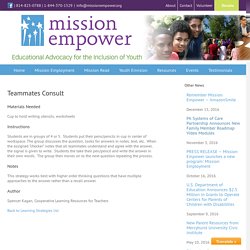
Students put their pens/pencils in cup in center of workspace. Notes This strategy works best with higher order thinking questions that have multiple approaches to the answer rather than a recall answer. Author. K20 LEARN. Cooperative Learning. Kagan. Kagan. InteractiveClassroomStrategiesandStructuresforSuccess Dr.FranciscaSanchez. Cooperative Learning Structures that Promote Second Language Learning (1) Breakouts To Energize Brains and Boost Achievement.
Two Ways To Form Breakout Groups 1.
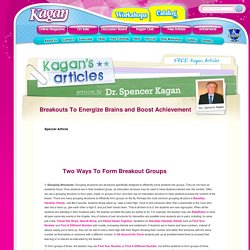
Grouping Structures. Grouping structures are structures specifically designed to efficiently move students into groups. They do not have an academic focus. Once students are in their breakout group, an interaction structure may be used to have students interact over the content. To form groups of three, the teacher may use Find Your Number or Find A Different Number, but tell the students to form groups of three. Sometimes when students are in pairs, we want to form groups of four. At times, we want teams to group with other teams to compare answers, exhibit and explain projects, and/or give each other feedback. Kinesthetic Symbols: Harnessing the Power of Gesturing. Dr.
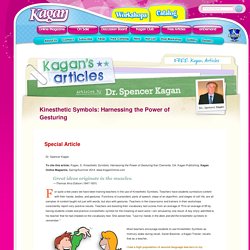
Spencer Kagan To cite this article: Kagan, S. Kinesthetic Symbols: Harnessing the Power of Gesturing San Clemente, CA: Kagan Publishing. Kagan Online Magazine, Spring/Summer 2014. www.KaganOnline.com Great ideas originate in the muscles. For quite a few years we have been training teachers in the use of Kinesthetic Symbols. 56 Kagan Co op Structures.
56 Kagan Co op Structures with links. 15 16 Classroom Strategies. Centerpiece. Cooperative Learning - Hesston Middle School. One of the areas that makes USD 460 and Hesston Middle School unique is the emphasis on incorporating cooperative learning structures into our daily classroom lessons.
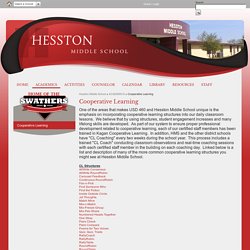
We believe that by using structures, student engagement increases and many lifelong skills are developed. As part of our system to ensure proper professional development related to cooperative learning, each of our certified staff members has been trained in Kagan Cooperative Learning. In addition, HMS and the other district schools have "CL Coaching" every two weeks during the school year.
AllWrite Consensus. Kagan Structures - Google Slides. RoundRobin / RallyRobin - Cooperative Learning Resources. Numberheadstip. Mod36 coop inside outside. Inside/Outside Circles. Teaching Social Studies and Language Arts. Sometimes students need to move, and sometimes teachers need to be entertained.

This is the perfect time for the Kagan strategy – Mix Pair Share. These are the “official” instructions: Mix Pair Share 1. students mix 2. teacher calls, “pair” 3. hand up, pair up 4. teacher asks question, gives think time 5. share This is what I like to do with the students: Students stand up by their desks.Teacher starts the music (I like something fun and energizing think “Funkytown” or “Everybody, Everbody”)Students mix – smiling, waving, bopping – but no talkingTeacher stops music and students pair with the closest person (I tell them, not the closest boy, not the closest girl, but the closest person)Students turn back to back.Teacher asks question and provides think time.Students turn and discuss question, then turn back to back.Teacher restarts music, and the cycle begins again if desired.
Now, that seems to have more steps, but it really goes pretty fast. Kagan structures. All Write Round Robin. Cur ela comcore write round robin. 5cooperative learning strategies. Think Pair Share Square (1) Mod36 coop 3 step interview. Comprehension Strategies - Teaching Strategies. Collaboration – Google Drive. Kagen Cooperative Learning Overview. Kagan strats. Coop Learning info all. Increase Student Interaction with "Think-Pair-Shares" and "Circle Chats" Background When I mentored student teachers I told them, "If I could offer one piece of advice for every teacher — it would be to do think-pair-shares in the class every day.
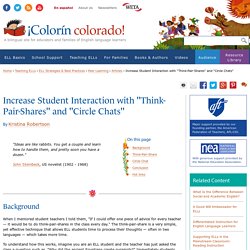
" The think-pair-share is a very simple, yet effective technique that allows ELL students time to process their thoughts — often in two languages — which takes more time. To understand how this works, imagine you are an ELL student and the teacher has just asked the class a question such as, "Why did the ancient Egyptians create pyramids? " Immediately students around the room shoot up their hands and offer answers. As an ELL student, you are still searching your memory banks to translate the words "ancient" and "pyramids. " At this point you may decide to offer an answer, but the teacher has already moved on and asked two new questions. Turn and Talk. Instructional Strategies. Coop Learning info all. Kagan Structures: A Miracle of Active Engagement. Cooperative Learning Lowers Anxiety Learning and using a foreign language can be stressful.
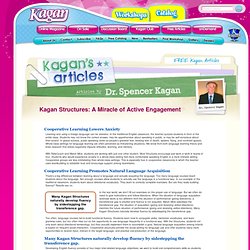
In the traditional English classroom, the teacher quizzes students in front of the entire class. Students may not know the correct answer, may be apprehensive about speaking in public, or may be self-conscious about their accent. In global surveys, public speaking ranks as people’s greatest fear, beating fear of death, spiders, flying, and confined spaces. Whole-class settings for language learning are often perceived as threatening situations. With RallyCoach and Match Mine, students are working with just one other student. (87) Kagan on Pinterest. Instructional Strategies. SIOP Activities per component A Newton 2 2013 23fmkwt. Rally_Coach.pdf. Using the Think-Pair-Share Technique. Our lesson plans are written and reviewed by educators using current research and the best instructional practices and are aligned to state and national standards.
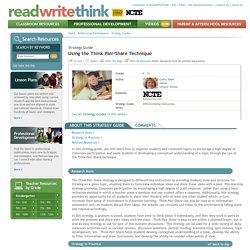
Choose from hundreds of topics and strategies. More Find the latest in professional publications, learn new techniques and strategies, and find out how you can connect with other literacy professionals. More Teacher Resources by Grade Home › Professional Development › Strategy Guides Strategy Guide Research Basis Strategy in Practice Related Resources. Cooperative Learning Strategies. Home > ELL Topics from A to Z > Cooperative Learning Strategies By: Colorín Colorado (2007) Cooperative Learning has been proven to be effective for all types of students, including academically gifted, mainstream students and English language learners (ELLs) because it promotes learning and fosters respect and friendships among diverse groups of students.
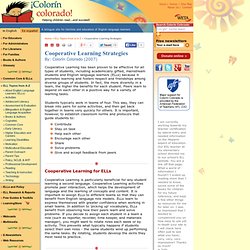
In fact, the more diversity in a team, the higher the benefits for each student. Peers learn to depend on each other in a positive way for a variety of learning tasks. Students typically work in teams of four. FocusingFour.pdf.